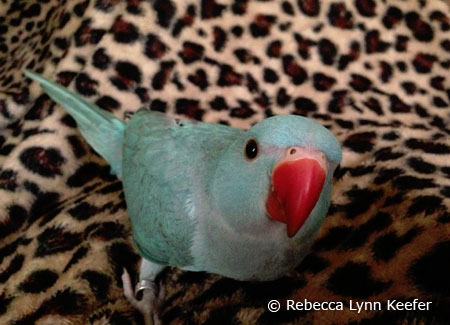Bird hELP CENTER
bird Question:
Indian Ringneck Female Biting Six Year Old
I'm very unsure of what to do right now. I have an IRN (Indain Ringneck). I've had her since well months now. I was hand feeding her formula when I first got her. She was originally very sweet. I started giving her free run of the house and all of a sudden she is biting and attacking my 6 yr old. She leaves the 3 yr old alone but she is real aggressive with my oldest. Any advice on how to stop this? Or should I start caging her more?

Answer:
Dear Rebecca Lynn Keefer,
While reading your response this issue of biting seems to be a
socialization matter. Female Indian Ringneck's are notoriously known for
expressing their likes and dislikes. For some reason, your bird has
chosen not to accept your six year old. I know it seems like the best
thing to do is to place her back in her cage as this will surely
minimize all biting. Though this may stop the problem for now, I believe
if you invest more time with socializing your bird she will come to
accept all people as friendly flock mates, including your six year old.
So how can this be achieved? First things first, your six year old
should stop giving her attention. This means no eye contact, handling,
or praising her. The more he interacts with her the more the behavior
becomes reinforced as she is learning that biting will push people away.
If not dealt with now, this will progress and it may lead to biting of
other household members.
The first part of your homework should be to never scold her or give your
bird attention when she exhibits this behavior towards your six year old. Then you
should immediately adopt a positive reinforcement program.
If you click
here you can read up more on the topic.
Once the bird understands how positive reinforcement works, it would be
wise for you and your friends to work on exercises that require the bird
to be with strangers. Often times, all that is needed is a few treats in
a friend's hand and the female will gladly step up without hesitation.
This should be practiced over and over until she feels comfortable doing
so without aggressive behavior. The goal is to think in patterns and to
repeat the process over and over. If this pattern is repeated the bird
will eventually come to look at all strangers as something positive and
rewarding.
Also, I might add that coaxing her to go to strangers is recommended,
but it is important she be able to back away should she feel
uncomfortable. The bird should never just be placed on a stranger as
this creates phobic behavior. The bird should choose to willingly step
up onto a stranger's hand and you should praise and reward her with your
voice and treats. Believe me, a female Indian Ringneck will quickly
catch on.
Any stranger looking to handle her must not make direct eye contact with
her until she is comfortable with them. Parrots are very perceptive to
what we are looking at and we don't want any biting. The goal is to omit
triggers that cause her to bite and to be able to eventually phase them
out. Should she bite anyone, and I stress this, ignore it as if nothing
has happened.
Also, you should start training your parrots to accept being placed on
its back, its toes touched, its beak touched, tail touched, and wings
opened without the bird biting. Take baby steps with positive
reinforcement training because this may take a few weeks or months.
Every bird is different. If the bird is able to master these exercises
this would easily transfer to strangers and your children. In the end she
will become more confident and a confident bird is usually a creature
that never bites and is lovable.
I'm afraid this is not going to be an overnight fix. But if you are
persistent and loving your bird will mold into a wonderful family
member. I commend you for seeking help in trying to change her behavior.
The important thing is to always remain calm and move forward with the
training. In time you'll have one cool bird that is friendly!
Best wishes, IMRAN-C




